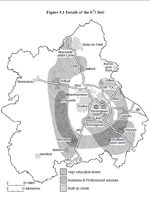Areas of translating research and the associated staff:
Particulate matter pollution in the UK - Roy Harrison
 Particulate Matter (PM) is now recognised as the air pollutant with the greatest public health impact, estimated to cost up to £8.5-20.2 billion per annum (in 2005). Professor Roy Harrison OBE has engaged closely with UK policy-makers for decades. His research has underpinned the extension of a Defra policy tool called Pollution Climate Mapping (PCM) to allow reliable prediction of PM pollution, and its attribution to different sources. As a result, the United Kingdom is able to reduce the costs of statutory air quality monitoring, and to develop cost-effective strategies for improvement of air quality, hence avoiding large EU financial penalties.
Particulate Matter (PM) is now recognised as the air pollutant with the greatest public health impact, estimated to cost up to £8.5-20.2 billion per annum (in 2005). Professor Roy Harrison OBE has engaged closely with UK policy-makers for decades. His research has underpinned the extension of a Defra policy tool called Pollution Climate Mapping (PCM) to allow reliable prediction of PM pollution, and its attribution to different sources. As a result, the United Kingdom is able to reduce the costs of statutory air quality monitoring, and to develop cost-effective strategies for improvement of air quality, hence avoiding large EU financial penalties.
Roy Harrison's staff profile
Jamie Lead – nanomaterials in the environment
 The research group at the University of Birmingham, led by Professor Jamie Lead, provides internationally recognised expertise in the synthesis and characterisation of manufactured nanomaterials and environmental fate and effects. As a result of the work at Birmingham, national and international risk assessments of nanomaterials have clarified the requirements for nanomaterial characterisation. It is important to characterise nanomaterials because their exposure, fate and toxicological effects depend very sensitively on details of their structure; details which are not always known or reported when a nanomaterial is fabricated. This research has influenced and is influencing public policy through changes to national and international guidelines. Jamie has also authored a British Standards Institute guidance document for characterization of nanomaterials in complex matrices, and so impacted on professional practice.
The research group at the University of Birmingham, led by Professor Jamie Lead, provides internationally recognised expertise in the synthesis and characterisation of manufactured nanomaterials and environmental fate and effects. As a result of the work at Birmingham, national and international risk assessments of nanomaterials have clarified the requirements for nanomaterial characterisation. It is important to characterise nanomaterials because their exposure, fate and toxicological effects depend very sensitively on details of their structure; details which are not always known or reported when a nanomaterial is fabricated. This research has influenced and is influencing public policy through changes to national and international guidelines. Jamie has also authored a British Standards Institute guidance document for characterization of nanomaterials in complex matrices, and so impacted on professional practice.
Jamie Lead's staff profile
Groundwater resource management and protection - John Tellam and Mike Rivett
 Groundwater research at the University of Birmingham has informed the development and management strategies for urban and other regional groundwater systems for more than 20 years in some cases, engaging with the Environment Agency, water utilities, and environmental consultants. The influence of this work has been economic (through improved public and private sector performance), professional (through the use of research results in the conduct of professional practice), and environmental (through improved management of a vital natural resource). This is illustrated by work on one of the UK’s major groundwater resources, the Permo-Triassic sandstone. University of Birmingham work on the Birmingham urban aquifer has enabled Severn Trent Water Ltd, for example, to develop it into a new resource (a £9M drilling programme with associated abstraction capacity worth several million pounds per annum), and provided a significant amount of the understanding and data necessary for the Environment Agency to develop its main management tool for this aquifer. Likewise, our research has provided much of the technical basis for new Environment Agency management strategies for the Liverpool/Manchester aquifer, an aquifer with an annual water supply capacity worth over £100M and a source replacement value in the range of £0.3-0.9 billion.
Groundwater research at the University of Birmingham has informed the development and management strategies for urban and other regional groundwater systems for more than 20 years in some cases, engaging with the Environment Agency, water utilities, and environmental consultants. The influence of this work has been economic (through improved public and private sector performance), professional (through the use of research results in the conduct of professional practice), and environmental (through improved management of a vital natural resource). This is illustrated by work on one of the UK’s major groundwater resources, the Permo-Triassic sandstone. University of Birmingham work on the Birmingham urban aquifer has enabled Severn Trent Water Ltd, for example, to develop it into a new resource (a £9M drilling programme with associated abstraction capacity worth several million pounds per annum), and provided a significant amount of the understanding and data necessary for the Environment Agency to develop its main management tool for this aquifer. Likewise, our research has provided much of the technical basis for new Environment Agency management strategies for the Liverpool/Manchester aquifer, an aquifer with an annual water supply capacity worth over £100M and a source replacement value in the range of £0.3-0.9 billion.
John Tellam's staff profile
Mike Rivett's staff profile
Keeping transport systems running in winter - Lee Chapman
 Route-based weather forecasting, using GPS and GIS technology, is being increasingly used by a number of organisations (e.g. local, airport and highways authorities) responsible for ensuring operational deliveries are maintained and meet planned schedules during winter. The original concept of using location and tracking technologies for weather forecasting and using it in this way was developed by work undertaken at the University of Birmingham, and subsequently formed the basis of a spin-out company. Sales from the company generated royalties for the University and developed the market for this type of product. Customers purchasing these products now enjoy business economic efficiencies, as well as ensuring reduced disruption and improved safety for transport users whilst ultimately reducing the impact of winter weather for the UK economy.
Route-based weather forecasting, using GPS and GIS technology, is being increasingly used by a number of organisations (e.g. local, airport and highways authorities) responsible for ensuring operational deliveries are maintained and meet planned schedules during winter. The original concept of using location and tracking technologies for weather forecasting and using it in this way was developed by work undertaken at the University of Birmingham, and subsequently formed the basis of a spin-out company. Sales from the company generated royalties for the University and developed the market for this type of product. Customers purchasing these products now enjoy business economic efficiencies, as well as ensuring reduced disruption and improved safety for transport users whilst ultimately reducing the impact of winter weather for the UK economy.
Find out more about Altasense
Lee Chapman's staff profile
Biodiversity in Cities: Understanding and developing awareness of wildlife in open spaces - Jon Sadler
 Balancing the demands of urban space for local people whilst ensuring biodiversity and important ecosystem functions are conserved in cities is difficult for urban planners. Work conducted by Professor Jon Sadler, in collaboration with a number of other research groups, sought to fill this knowledge gap by modelling all the significant elements required to achieve the optimal balance. Through this work, authorities and planners have developed a better understanding of the implications for nature when designing urban environments and the features required to preserve and enhance existing wildlife. A critical outcome of the work was that local people needed to be engaged with nature as part of living in a city.
Balancing the demands of urban space for local people whilst ensuring biodiversity and important ecosystem functions are conserved in cities is difficult for urban planners. Work conducted by Professor Jon Sadler, in collaboration with a number of other research groups, sought to fill this knowledge gap by modelling all the significant elements required to achieve the optimal balance. Through this work, authorities and planners have developed a better understanding of the implications for nature when designing urban environments and the features required to preserve and enhance existing wildlife. A critical outcome of the work was that local people needed to be engaged with nature as part of living in a city.
In support of this, a huge amount of regional science outreach work across the country was instigated through the Open Air Laboratories (OPAL) project. OPAL created a wide range of engagement opportunities to help people interact with their local spaces, train citizen scientists, and to raise awareness of the importance of wildlife in urban areas. Over 25 thousand people participated in the programme, though events, training, management of local wildlife patches and conducting biological surveys in their locality in conjunction with voluntary, community and statutory organisations. In addition to the impact on those members of the public who participated (for example, changing their perspectives and interest in the local environment and learning new skills), primary and secondary schools have benefited from collaborating with the researchers to create new activities and information packs in support of the curriculum, helping improve student skills and interest in science. Additionally, local wildlife trusts and community groups (such as those centred on natural history, gardening, local wildlife and bee keeping) benefited from opportunities to share data and work with people in their local environment.
Jon Sadler's staff profile
Identifying the economic belt of activity in the West Midlands - John Bryson
 The West Midlands is an area with nearly 2 million people, 835,000 jobs and a Gross Value Added of approximately £34 billion. By defining, understanding and mapping the economic geography within such an area, appropriate management structures and economic policy can be developed that support increased economic development and maximisation of potential of existing assets. Research led by Professor John Bryson, in collaboration with others, analysed the West Midlands in this way and identified where business and professional services were located, the distinctive nature of different parts of the region, and the relationships between and within them. The innovative approach used in this research identified a ‘belt’ of activity away from the city centre, which had not been considered in the existing regional economic policy. This prompted the development of a new strategy by the Regional Development Agency at the time as well as influencing the boundaries of the Great Birmingham and Solihull Local Enterprise Partnership in 2010. The outcome has led to improved economic planning and development in Birmingham, Solihull, Warwickshire, Worcestershire, Staffordshire and Shropshire.
The West Midlands is an area with nearly 2 million people, 835,000 jobs and a Gross Value Added of approximately £34 billion. By defining, understanding and mapping the economic geography within such an area, appropriate management structures and economic policy can be developed that support increased economic development and maximisation of potential of existing assets. Research led by Professor John Bryson, in collaboration with others, analysed the West Midlands in this way and identified where business and professional services were located, the distinctive nature of different parts of the region, and the relationships between and within them. The innovative approach used in this research identified a ‘belt’ of activity away from the city centre, which had not been considered in the existing regional economic policy. This prompted the development of a new strategy by the Regional Development Agency at the time as well as influencing the boundaries of the Great Birmingham and Solihull Local Enterprise Partnership in 2010. The outcome has led to improved economic planning and development in Birmingham, Solihull, Warwickshire, Worcestershire, Staffordshire and Shropshire.
The Functioning Economic Geography of the West Midlands Summary Report (PDF 4.63MB)
Greater Birmingham & Solihull Local Enterprise Partnership website
Challenging conventional wisdom in the housing sector
 Research conducted by the University of Birmingham has explored the varied socio-spatial implications of transition to a low-carbon built environment - particularly focusing on the sector of housing and household energy vulnerabilities. While much policy attention has been on the benefits of the transition towards energy-efficient and low-carbon housing, the complex interplays with the broader aspects of sustainability, affordability, equity and societal cohesion are rarely duly considered. The work by Birmingham provides a strong argument to change the conventional policy approaches by prioritising the aspects of social justice and inclusiveness in governing energy transitions. The outcomes have influenced United Nations work in the field of housing and land management and, in turn, have informed the private sector, EU and national government and non-governmental organisational decision-making on sustainable housing and urban development, to guard against energy poverty and vulnerability and to make appropriate decisions on planning and delivering equitable and sustainable energy in the housing sector.
Research conducted by the University of Birmingham has explored the varied socio-spatial implications of transition to a low-carbon built environment - particularly focusing on the sector of housing and household energy vulnerabilities. While much policy attention has been on the benefits of the transition towards energy-efficient and low-carbon housing, the complex interplays with the broader aspects of sustainability, affordability, equity and societal cohesion are rarely duly considered. The work by Birmingham provides a strong argument to change the conventional policy approaches by prioritising the aspects of social justice and inclusiveness in governing energy transitions. The outcomes have influenced United Nations work in the field of housing and land management and, in turn, have informed the private sector, EU and national government and non-governmental organisational decision-making on sustainable housing and urban development, to guard against energy poverty and vulnerability and to make appropriate decisions on planning and delivering equitable and sustainable energy in the housing sector.